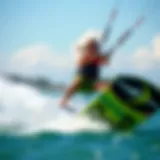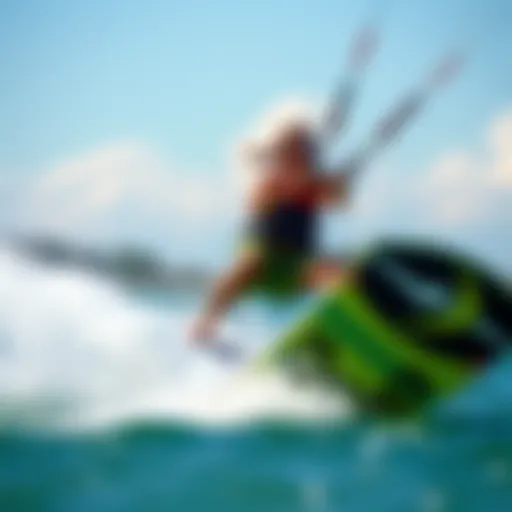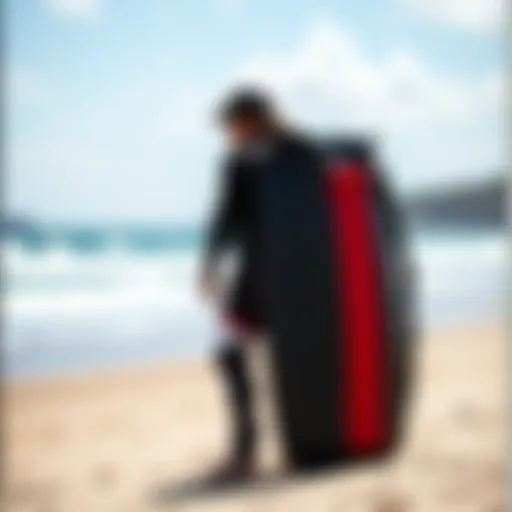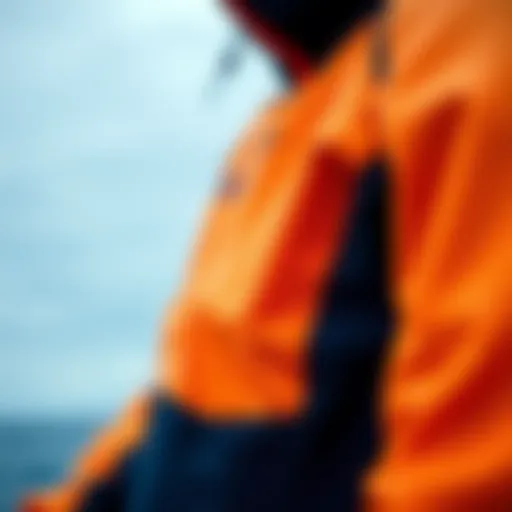Discovering Carbon Fiber Masts for Kiteboarding
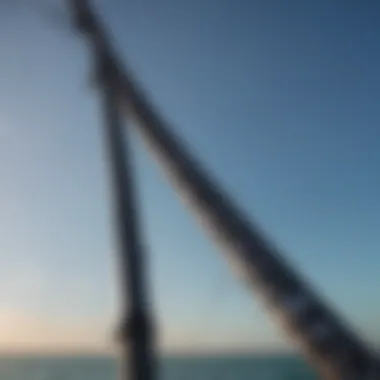

Intro
Carbon fiber masts have made quite a splash in the kiteboarding community, fundamentally altering how enthusiasts engage with the sport. When you peel back the layers, these masts aren’t just a splash of modern technology; they represent a leap into performance and efficiency. With the growing popularity of kiteboarding, understanding the nuances of these materials can give kiteboarders a serious edge on the water.
For many new riders, it’s a dizzying array of choices. The market’s filled with products promising extraordinary benefits. A well-informed decision can mean the difference between a blissful day soaring through the waves and a frustrating experience battling poor equipment. This guide aims to clarify the whole thing, shedding light on the significance of carbon fiber masts – from their inherent advantages to their practical applications in real-world kiteboarding scenarios.
As we journey through the ins and outs of this topic, we’ll unravel the characteristics that set carbon fiber apart from traditional materials. We’ll examine how they impact kite performance, which brands are market leaders, and tips to help you maintain your equipment, thereby prolonging its lifespan. Grab your gear, and let’s dive in!
Prelims to Carbon Fiber Masts
When it comes to kiteboarding, the conversation often drifts towards gear and equipment that can influence overall performance on the water. Among these components, carbon fiber masts specifically stand out as crucial assets. This section delves into the nature and value of these masts, highlighting why they have become the go-to choice for many kiteboarders.
What is a Carbon Fiber Mast?
At its core, a carbon fiber mast is a long, slender pole constructed from woven strands of carbon fibers. These fibers are renowned for their high tensile strength, which means they can support heavy loads without breaking. Unlike aluminum or fiberglass masts, carbon fiber masts offer a remarkable balance of lightness and toughness. They often look sleek and can be found in various lengths and designs tailored to different kiteboarding styles.
Owners of carbon fiber masts will notice how these poles perform well under pressure, bending rather than snapping, which can be a game-changer when catching air. To put it plainly, investing in a carbon fiber mast is like having the best sword in a warrior’s arsenal - it’s not just about the look; it’s about how well it performs when it really counts.
Importance in Kiteboarding
The significance of carbon fiber masts in kiteboarding cannot be overstated. These masts play a pivotal role in the dynamics of kite control, creating a more efficient and enjoyable ride. Here are a few key reasons why they are highly regarded:
- Enhanced Responsiveness: Kiteboarders will find that carbon fiber masts tend to react quicker to input, allowing for immediate changes in direction and speed. This responsiveness can be particularly advantageous in tricky wind conditions.
- Improved Fuel Efficiency: Kite performance is heavily reliant on the weight of the gear being used. Carbon fiber masts will typically decrease overall weight. A lighter setup allows for less effort while riding, leading to longer sessions on the water.
- Increased Durability: Given their structural integrity, carbon fiber masts face challenges that would weaken other materials. These masts can stand the test of harsh weather and rough usage, making them a smart long-term investment for enthusiasts and professionals alike.
In essence, opting for a carbon fiber mast is a decision fueled by practicality and performance. A solid understanding of these characteristics equips kiteboarders with the knowledge to make informed gear choices, enhancing their overall experience on the water. Moreover, it settles the age-old debate of materials: why go with the past when you can invest in the future?
Advantages of Carbon Fiber
Carbon fiber has firmly established itself as a premier material in the world of kiteboarding. It offers a set of unique benefits that contribute not only to the performance of the kite but also to the overall enjoyment of the sport. This section will delve into the key advantages of carbon fiber, emphasizing aspects that kiteboarders should keep in mind when considering their options. With a few notable differentiators, it's clear why many enthusiasts are gravitating towards these lightweight, durable masts.
Lightweight Nature
One of the most significant advantages of carbon fiber masts is their lightweight nature. Kiteboarding heavily relies on the rider’s ability to maneuver, and having equipment that is light can make all the difference. A mast made of carbon fiber can weigh as little as half that of its aluminum or fiberglass counterparts. This reduction in weight results in more responsive handling, allowing the kiteboarder to make sharper turns and achieve higher speeds.
Moreover, the feather-light quality lessens the fatigue during longer sessions, enabling riders to stay out on the water longer without feeling bogged down. Imagine cruising over the water, feeling that brilliant breeze, but knowing that your mast is a fraction of the weight. That’s pure bliss for any kiteboarder.
Durability and Strength
When it comes to durability and strength, carbon fiber offers an impressive advantage. The material is able to withstand considerable tension without bending or breaking. This resilience means that a carbon fiber mast can endure the rigors of high-intensity kiteboarding, from massive jumps to quick directional changes, without any potential damage.
Unlike fiberglass which can crack under stress, or aluminum that may corrode when exposed to saltwater, carbon fiber maintains its integrity over time.
"A good mast is like a good partner; it sticks with you through thick and thin," is a sentiment shared by many experienced kiteboarders when discussing their preferred gear. Investing in a carbon fiber mast is investing in a long-lasting ally for your kiteboarding adventures.
Flexibility in Design
Design flexibility is another feather in carbon fiber's cap. Manufacturers can easily shape and mold carbon fiber masts into various styles and dimensions, allowing for customized options tailored to specific kiteboarding needs. This adaptability is crucial because different kite styles and rider preferences dictate different performance requirements.
For instance, a rider focused on freestyle might choose a stiffer mast for better performance during tricks, while someone interested in wave riding may prefer more flexibility for smoother rides on choppy waters. This level of customization is often harder to achieve with traditional materials, giving carbon fiber masts an edge in performance adaptability.
Factors to Consider When Buying
When it comes to selecting a carbon fiber mast for kiteboarding, a careful assessment is crucial. The decision often boils down to various factors that can make a significant difference in your performance and experience on the water. Making an informed choice can mean the difference between a disappointing day out on the waves and achieving that exhilarating ride you’ve always desired.
Budget Considerations
Purchasing a carbon fiber mast can be a substantial investment, and it’s vital to have a clear idea of what you are willing to spend before diving headlong into the options available. Generally, you could find masts ranging from a few hundred to several thousand dollars. It's important to keep in mind that while cheaper alternatives may seem enticing, they often compromise on quality, which might lead to issues down the line. If you’re serious about kiteboarding, allocate a budget that aligns with your performance goals. Think of it this way: further investing in quality masts could potentially save you money over time by ensuring durability and performance.
“Investing in quality gear is like paying for a ticket to adventure. You wouldn’t want it to be a short ride.”
Performance Requirements
Next comes the aspect of performance requirements. Kiteboarding is a sport where the right equipment can make you feel like you’re flying. Different masts offer varied degrees of stiffnes, flexibility, and responsiveness. Assess your skill level and riding style. Are you a beginner looking for stability, or an advanced rider craving speed and maneuverability? Some riders might prioritize weight, preferring lighter masts for easier handling. It’s essential to choose a mast that complements your individual performance needs, as this can significantly enhance your overall riding experience.
Brand Reputation
Last but certainly not least is the consideration of brand reputation. In the niche of kiteboarding, several brands have established themselves as leaders due to their quality and innovation. Researching brands will give you insight into their manufacturing standards and customer feedback. A reputable brand typically indicates reliability and performance; thus, taking time to read reviews can prove invaluable. Websites like Reddit often host discussions among kiteboarders who share their experiences with different brands, providing you a behind-the-scenes look at what to expect.
When all is said and done, blending your budget, performance needs, and trust in a brand can create a harmonious foundation for your kiteboarding pursuits.
Popular Brands of Carbon Fiber Masts


When it comes to carbon fiber masts in kiteboarding, the brand can make a significant difference in performance, durability, and overall user satisfaction. A knowledgeable kiteboarder understands that selecting the right mast brand is akin to picking a reliable partner on the water. Hence, investing time in understanding various brands is crucial. Your choice could impact not only your kiteboarding experience but also your safety and equipment longevity.
Liken it to choosing a trusty steed – you need one that can gallop smoothly across the waves, withstand the elements, and serve you well in every exhilarating ride. Let's delve into three notable brands in the carbon fiber mast market that kiteboarding enthusiasts often turn to for their performance and reliability.
Brand A Overview
Brand A has carved a niche for itself in the kiteboarding community, known for its top-notch carbon fiber masts. They focus heavily on engineering precision, employing cutting-edge technology that results in remarkably lightweight and frim masts. One claim to fame for Brand A is its continuous improvement processes; they actively gather user feedback and implement changes accordingly.
- Key Features:
- Lightweight design for enhanced agility.
- High durability, resisting potential impacts and wear.
- Innovative manufacturing techniques that ensure smooth handling.
Many users rave about the stiffness of these masts, as it translates to superior power transmission when in action. Their prices tend to reflect the quality, appealing mainly to dedicated riders looking for that edge in performance.
Brand B Overview
Brand B is celebrated for balancing affordability with performance. Their masts are crafted from high-quality carbon fiber but at a more accessible price point compared to some competitors. This makes them a popular choice among both novice and seasoned kiteboarders. Brand B prides itself on maintaining a vast lineup of products that cater to different riding styles and conditions.
- Key Features:
- Versatile selection suitable for various kite types.
- Excellent rigidity without significant weight.
- Good customer service and warranty policies.
Though they may not compete with the top-tier brands in absolute performance, many find that Brand B offers the best bang for the buck. They are recognized for retaining value, often remaining a popular choice even in the second-hand market.
Brand Overview
Brand C is a name synonymous with innovation and high-end performance. They often take the lead in introducing new technologies and materials into their product lines. For avid kiteboarders who seek every possible advantage on the water, Brand C has garnered respect for its research and development efforts.
- Key Features:
- Advanced technology that optimizes strength-to-weight ratios.
- Sleek designs that enhance aerodynamics.
- Broad compatibility across various kite models.
Kiteboarders who have the budget often gravitate towards Brand C, particularly when looking for high-performance masts intended for competition level. Yet, this premium comes at a price; thus, not every rider may find it essential in their arsenal.
In the world of kiteboarding, having the right brand can mean the difference between a mediocre day on the water and an exhilarating experience.
Navigating through these popular brands will arm you with the knowledge needed to make an informed choice when purchasing your carbon fiber mast. Each brand has something distinctive to offer, ensuring that action-packed adventures are well within your reach.
Where to Find Carbon Fiber Masts for Sale
Finding the right carbon fiber mast is as important as the mast itself when it comes to enhancing your kiteboarding experience. Whether you’re a beginner or an experienced kiteboarder, knowing where to purchase these essential components can make all the difference. From online options to local shops and even second-hand markets, this section explores the various avenues for acquiring carbon fiber masts, delving into the benefits, considerations, and tips for making an informed choice.
Online Retailers
The world of online shopping opens up a treasure trove of possibilities for kiteboard enthusiasts. A mere click can lead you to several retailers featuring a diverse selection of carbon fiber masts. Shopping online not only gives access to a broader range of brands and models, but it also offers the convenience of comparing prices with just a few taps on your mobile device.
When browsing online, keep an eye out for customer reviews and product ratings. These insights can illuminate the experiences of fellow kiteboarders, guiding you towards the most suitable mast for your needs. Furthermore, many online retailers offer detailed specifications and sometimes even video demos, providing you a clearer picture of the product.
However, always check for return policies before committing to a purchase. Buying online might feel like a gamble without the chance to physically inspect the mast, so ensure that you can return or exchange if it doesn’t meet expectations.
Local Shops and Stores
There’s something to be said about the experience of shopping in person. Local shops and stores often provide a more tactile approach to buying a carbon fiber mast. Touching and feeling the equipment can lead to a better understanding of the material’s weight and flexibility. You might even find store employees who are kiteboarding enthusiasts themselves, ready to share their knowledge and offer personalized recommendations.
One key advantage here is the opportunity for local support. Should you encounter issues with your mast post-purchase, having a nearby shop can speed up resolution times significantly. Plus, some stores may even provide trails where you can test different models before making your purchase. This hands-on experience, combined with expert advice, can sometimes steer you toward a better choice than what you might find online.
Second-Hand Markets
For those keen on saving pennies while still snagging a quality carbon fiber mast, second-hand markets are worth exploring. Places like local classifieds, online marketplaces, and social media groups dedicated to kiteboarding often host a medley of used gear.
Buying used presents its pitfalls, of course. You need to keep your eyes peeled for signs of wear and tear. Look for any cracking or visible damage, as even small imperfections could lead to catastrophic failure on the water. Ask the seller about the history of the mast, how often it’s been used, and whether it has ever been involved in accidents.
Communities like reddit.com can be great resources when it comes to finding used gear, as well as for advice on what to inspect before committing. Other kiteboarders might have firsthand knowledge about reputable sellers or dealers within your region.
Remember: A second-hand mast can also be an opportunity for newcomers to enter the sport without breaking the bank. However, always prioritize safety and quality over price when making your choice.
Understanding Technical Specifications
Understanding the technical specifications of carbon fiber masts is essential for kiteboarders, instructors, and enthusiasts alike. Whether you're a seasoned pro or just dipping your toes into this thrilling sport, knowing the ins and outs of mast specifications can make a world of difference in your performance on the water. These specifications not only influence how a kiteboard operates but also directly impact your safety, comfort, and overall kiteboarding experience.
Length and Weight Considerations
When it comes to length, carbon fiber masts come in various sizes, and choosing the right one plays a crucial role in your kiteboarding experience. Generally, the longer the mast, the more lift it can provide, allowing for better upwind performance and stability during higher speeds. Conversely, shorter masts offer increased maneuverability, making them perfect for technical tricks and tight turns.
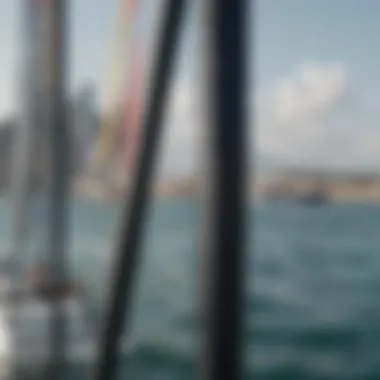

Weight, on the other hand, is a critical factor as well. A lightweight mast enhances your ability to pop and maneuver quickly, while also reducing fatigue during long sessions on the water. However, it’s vital to strike a balance. A mast that is too light may sacrifice durability and strength. To summarize:
- Longer Masts: Better lift and stability but can be unwieldy.
- Shorter Masts: Easier to handle for tricks but may struggle in upwind conditions.
- Lightweight Masts: Mitigate fatigue but consider durability at the same time.
Compatibility with Kites
Compatibility cannot be overlooked. Each kite is designed with specific mast specifications in mind. A mast not tailored for your kite model may lead to subpar performance or even equipment damage. Before purchasing, always check the manufacturer's recommendations and consider factors like the mast's flex patterns and stiffness, which need to harmonize with the design of your kite.
For instance, stiffer masts provide more direct energy transfer, enhancing responsiveness. This is ideal for high-wind conditions but might be less forgiving for beginners. On the flip side, a more flexible mast may soak up the shock during windy or choppy conditions, perfect for casual riding or less aggressive styles:
- Choose Compatible Sizes: Align your mast’s length with the recommended specifications of your kite.
- Flex Patterns Matter: Assess whether stiffness meets your riding style preferences.
- Manufacturer Guidelines: Reference specific recommendations before making any purchase.
Testing and Certification Standards
In the realm of kiteboarding, safety must always come first. That's where testing and certification standards come into play. Most reputable manufacturers subject their carbon fiber masts to rigorous testing to ensure they can withstand the harsh conditions seasoned riders may encounter.
Certification can provide peace of mind when purchasing a mast. Look for industry recognitions or testing standards, guiding you toward products that are built to last. These could include:
- ISO Certifications: International standards for quality assurance.
- Material Verifications: Proof that materials meet specified criteria.
Always prioritize safety; a mast that has passed stringent testing ensures a more stable riding experience.
All in all, each technical specification offers unique benefits. When selecting a carbon fiber mast, think critically about how length, weight, compatibility, and testing standards align with your specific riding style and conditions. Getting these right can be the difference between a mundane session and an exhilarating day on the glide!
Comparing Carbon Fiber to Other Materials
When it comes to kiteboarding, the materials that make up the gear can significantly affect performance. Understanding how carbon fiber stacks up against other materials like fiberglass and aluminum can help kiteboarders make informed decisions. Each material has its own unique characteristics, benefits, and limitations. This comparison is crucial, as it shapes a rider's experience on the water, influencing factors such as durability, weight, and overall feel.
Fiberglass Versus Carbon Fiber
Fiberglass has long been a staple material in the kiteboarding industry. Its affordability and decent strength made it a popular choice, especially among beginners. However, when you pit fiberglass against carbon fiber, fundamental differences surface.
Carbon fiber masts are notably lighter than their fiberglass counterparts, which translate to easier maneuverability. This lightweight nature allows for quicker responses and better control. In contrast, fiberglass tends to weigh down a setup, especially in larger masts.
Moreover, carbon fiber exhibits greater stiffness. This rigidity means that when a kite is put under load, carbon masts maintain their form better than fiberglass ones. Consequently, this leads to improved efficiency and power transfer. Riders can feel the difference, experiencing enhanced lift and speed on the water.
Nevertheless, fiberglass isn't without its merits. One can find fiberglass masts at a lower price point, making them accessible for newcomers. It's also worth noting that fiberglass has in general a softer flex, providing a softer ride that some might prefer in certain conditions. Overall, while fiberglass offers value, serious kiteboarders often gravitate towards carbon fiber for its performance benefits.
Aluminum Versus Carbon Fiber
Aluminum is another contender often used in the kiteboarding arena. It offers significant strength and durability. However, similarities end quickly as advantages arise when one turns the eye to carbon fiber.
In terms of weight, aluminum masts are heavier, which can lead to less responsive movements and might require more effort to handle over extended sessions. Carbon fiber, being lighter, makes for all-day comfort on the water.
One of the more subtle yet important differences is in vibration dampening. Carbon fiber has superior shock-absorbing properties, reducing the unwanted vibrations that can be transmitted through the mast. This characteristic leads to a smoother ride, especially in choppy conditions that aluminum might struggle with.
On the downside, aluminum is arguably more robust against impacts, making it a potential choice for those prone to crashes or heavy use. However, traditional aluminum masts often do not offer the same optimization for performance that carbon fiber provides. Riders focused on exploiting speed and agility will likely pick carbon fiber, even if it's a bit pricier.
In summary, each material has its place in kiteboarding. Yet, when performance is paramount, the allure of carbon fiber remains hard to resist. Choosing wisely can mean the difference between just riding the waves and taking flight upon them.
Maintenance of Carbon Fiber Masts
Taking care of carbon fiber masts is crucial for anyone getting serious about kiteboarding. While these masts are renowned for their strength and lightweight nature, they still require proper maintenance to ensure they perform optimally over time. Ignoring maintenance can lead to a decline in performance and, ultimately, costly replacements. By adopting a routine that prioritizes cleaning and monitoring for wear, kiteboarders can extend the lifespan of their equipment and maintain the high levels of performance necessary for exhilarating rides.
Cleaning and Care Tips
Maintaining the cleanliness of your carbon fiber mast is akin to taking care of an expensive sports car. Here are essential tips to keep your mast in top shape:
- Rinse After Use: Always rinse your mast with fresh water after coming off the water. Saltwater can lead to corrosion and buildup if left unattended.
- Use a Soft Cloth or Sponge: For cleaning, avoid abrasive materials that could scratch the surface. A gentle cloth or sponge will do just fine to remove dirt and residue.
- Avoid Harsh Chemicals: Stick to mild soap and water for cleaning. Harsh chemicals can degrade the resin over time, weakening the structure.
- Dry Thoroughly: Make sure to dry the mast completely before storing it. A damp environment can invite mold or damage the inner foam core.
- Inspect Regularly: As you clean, take the opportunity to look for any signs of damage or wear. Early intervention can save you time and money in the long run.
By incorporating these practices into your post-session routine, you can ensure that your carbon fiber mast stays clean and performs up to par.
Signs of Wear and Tear
Keeping an eye out for signs of wear and tear on your mast is essential for ensuring a safe and enjoyable kiteboarding experience. Here are some indicators that your mast may need a closer look or even replacement:
- Visible Cracks or Splits: Any noticeable cracks on the surface can indicate structural weakness. Even small cracks can worsen over time, affecting performance.
- Delamination: If you see layers peeling apart, that's a classic sign of delamination. It means the bond between the layers is breaking down, which is a significant red flag.
- Discoloration: Fading or discoloration isn't just cosmetic; it may indicate breakdown in the material from UV exposure.
- Flexibility Changes: If the mast feels less responsive or begins to bend in unexpected ways during rides, it's worth investigating.
- Sound Changes: Pay attention to any unusual noises that may occur when you flex or move the mast. A difference in sound can indicate damage that isn't immediately visible.
Remember: Regular inspections and awareness of these signs are vital. Addressing any issues early can help avoid accidents or costly replacements.
In summary, taking the time to maintain your carbon fiber mast through cleaning and monitoring for wear significantly contributes to a better kiteboarding experience. Ensuring your equipment is in prime condition allows for both safety and peak performance on the water.
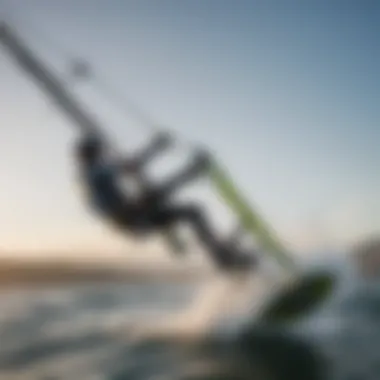

User Experiences and Testimonials
The realm of kiteboarding is more than just about the gear; it’s about the stories shared among enthusiasts and the wisdom passed down through first-hand experiences. When kiteboarders discuss carbon fiber masts, they bring essential insights that can guide newcomers and seasoned riders alike in making informed decisions before investing in their equipment. This section explores user experiences and testimonials to shed light on the real-world implications of choosing carbon fiber masts over other materials.
Interview with Expert Kiteboarders
Hearing from those who have significant experience with various mast types can be invaluable. Expert kiteboarders not only test the boundaries of technology but also live the practical consequences of their gear in varying conditions. Recently, I had the chance to catch up with several seasoned kiteboarders—people who have been riding the waves for years, some even since the inception of kiteboarding itself.
One expert, Lisa Ortega, pointed out how her shifts towards carbon fiber masts dramatically changed her performance. "With older aluminum masts, I often felt weighed down, and the stability they offered felt less dependable in strong winds," she explained. "Switching to carbon fiber made such a difference; it’s way lighter, and I can feel how it flexes just enough to absorb the shock on rough days. It's like night and day!"
The insights from these conversations show a common consensus: lighter masts lead to swifter turns, reduced fatigue, and an overall enhanced riding experience. The interviews highlight not just technical specifications, but how the experience on the water feels at a visceral level. Here, factual data meets personal sentiment, painting a clearer picture of what kiteboarders should expect when exploring carbon fiber.
Community Feedback on Performance
Besides the expert views, community feedback plays an equally essential part. Online forums and local kiteboarding groups are buzzing with discussions about the pros and cons of carbon fiber masts. These platforms allow ordinary riders to share their experiences, building a large repository of knowledge.
Participants typically compare performance factors like weight, durability, and responsiveness. For instance, a post on reddit.com recently detailed a user’s transition from fiberglass to carbon fiber. They shared their findings after a season of use: "My jumps are way higher and smoother with the carbon. I can ride longer without feeling knackered—definitely worth the investment!"
When digesting this feedback, it’s also critical to consider the maintenance aspect. Multiple users reported that while carbon fiber can be more sensitive to impacts, with the right care, they perform commendably and offer prolonged periods of satisfaction.
Furthermore, riders often appreciate the aesthetic appeal of carbon fiber, noting its sleek look as well as its performance edge. This aspect shouldn’t be underestimated; the visual impact can engender pride among kiteboarders, enhancing overall enjoyment.
Gathering these first-hand accounts and individualized testimonials illustrates the tangible benefits of carbon fiber masts in kiteboarding, providing potential buyers with thoughtful insights as they journey into selecting the right gear.
Future Trends in Mast Technology
As kiteboarding evolves, the technology surrounding it is also undergoing rapid changes. The trends in mast technology are crucial because they not only affect how kiteboarders perform on the water but also influence the longevity and appeal of equipment choices. The advent of new materials and advancements in customization are paving the way for a more personalized and high-performance kiteboarding experience.
Innovations in Materials
The materials used in the construction of carbon fiber masts are hitting new heights. Unlike traditional mast materials, the latest carbon compositions are being enhanced with nanotechnology. This innovation allows for masts that are not just lightweight but also incredibly strong, offering improved stability and reduced twist during intense maneuvers. The layering techniques applied in these masts provide varied flex characteristics tailored for different riding styles—from freestyle to racing.
A growing trend is the integration of recycled materials into the manufacturing process. This approach addresses environmental concerns while still delivering high-quality performance. Additionally, some manufacturers are experimenting with hybrid materials, combining carbon fiber with other composites to optimize wave response without sacrificing weight.
Among these innovative materials, one also finds a focus on finishes. Resistant coatings are being applied to protect against UV damage and the abrasive nature of saltwater, extending the lifespan of the equipment sitting in the garage or on the beach.
"The frontier of materials science is shifting the way we kiteboard. It's not just about lighter gear; it's about smarter gear that enhances every ride."
Customization Options
Customization is becoming increasingly vital in mast technology, allowing kiteboarders to tailor their gear precisely to their needs. Savvy kiteboarders now desire equipment that reflects their personal styles and performance requirements. Customization ranges from altering the length and stiffness of the mast to selecting specific flex patterns that harmonize with particular kites.
Many brands now offer modular mast systems where riders can easily swap out sections to adapt to varying wind conditions or personal preferences. This flexibility can dramatically affect performance; different setups can cater to everything from light wind cruising to high-performance jumping.
In addition, advanced design software is emerging, enabling kiteboarders to simulate how different mast configurations will perform in various conditions. This bespoke approach empowers riders to experience more than just a one-size-fits-all solution.
As the market expands, the customization possibilities continue to push the boundaries of what kiteboarding gear can achieve, making it an exciting space for both manufacturers and enthusiasts.
With innovations converging on performance and personalization, kiteboarders can look forward to not just riding the waves, but riding them their way.
Ending
As we wrap up our exploration of carbon fiber masts, it's crucial to focus on the main takeaways from this comprehensive guide. This section not only ties up the various threads we’ve discussed but highlights why these masts matter significantly to kiteboarding enthusiasts. With their lightweight nature and durability, carbon fiber masts have truly transformed the way kiteboarders approach both performance and ease of use on the water.
Importance of Selection
When selecting a carbon fiber mast, it's important to consider not just the price but also the performance requirements tailored to your unique style and skill level. The balance between flexibility and sturdiness can make or break your experience out there. Moreover, understanding the user feedback and the different specifications can enhance your decision-making process. This is vital, especially for those looking to push their limits and experience the thrill that kiteboarding provides.
"A quality mast is like the backbone of your kite. Get it right, and you’ll slice through waves with grace."
Benefits of Knowledge
In summary, knowledge about the characteristics of carbon fiber masts helps riders make informed choices. The insights into maintenance also offer long-term benefits, ensuring that your equipment remains in superb shape for years to come. This guide serves as a valuable resource, shedding light on the nuances of usage and care that can lead to an enriched kiteboarding journey.
Overall, investing time in researching and understanding carbon fiber masts will not only improve your performance but also enhance your enjoyment in kiteboarding, propelling you toward greater adventures.
Final Thoughts on Selection
Choosing the right carbon fiber mast can feel overwhelming, but having a structured approach can simplify the process. Focus on your needs and what suits your kiteboarding style. If you thrive on speed, look for lightweight options that cater to this preference. Conversely, if you prioritize robustness, ensure the mast can handle gusty winds or letdowns on the water.
Here are some key factors to keep in mind when selecting a mast:
- Length: Ensure you pick a length compatible with your kite and riding style.
- Weight Ratings: Know your own weight and consider how it aligns with the mast’s capabilities.
- Type of Riding: Different masts may serve better for freestyle, wave riding, or racing.
- Budget Limits: Match your choice with what you are willing to invest while keeping quality in mind.
Near the end of the day, a well-selected mast can profoundly affect your overall kiteboarding experience. Put thought into it, and you can find something that complements your passion for speed and adventure.
Encouragement for Further Exploration
As kiteboarding continues to evolve, so does the technology surrounding it, especially with materials like carbon fiber. Don't stop at just choosing the perfect mast; delve deeper into the world of kiteboarding gear to maximize your experience. Engage with the community; forums like reddit.com have enthusiasts sharing their own experiences and recommendations.
Expand your knowledge through observations and interactions. Experiment with different setups, and don’t shy away from learning about the latest advancements in gear. Innovations in material science, such as improvements in carbon fiber composites, might provide even better options down the line. Follow updates from brands and connect with fellow enthusiasts on social media, such as Facebook.
The more informed and curious you are, the more you can enhance your skills and broaden your perspectives in kiteboarding. Embrace this journey—there’s always something new to learn, and every session on the water is a chance to evolve as a kiteboarder.
Engage, explore, and enjoy the ride!
